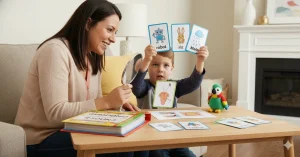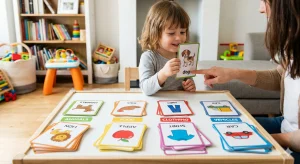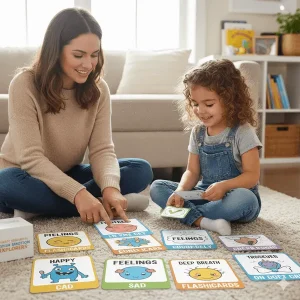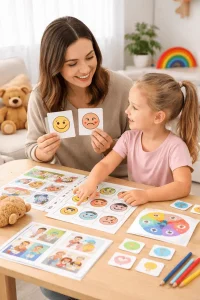Effective Autism Therapies Parents Can Do at Home
By Wellness Hub
Last Updated: September 27, 2024
Parenting a child with autism comes with its own unique set of challenges and rewards. Every day can bring new experiences and learning opportunities, but it can also present difficulties that require patience and understanding. As a parent, you play a crucial role in supporting your child’s development and helping them navigate the world. One of the most effective ways to support your child is through home-based autism therapies. These therapies are not only convenient and cost-effective but also allow you to integrate therapeutic activities into your daily routine, fostering a stronger bond with your child. By incorporating these techniques at home, you can create a supportive environment tailored to your child’s needs.
Understanding Home-Based Autism Therapies
Autism therapies are designed to support the development of children with autism by helping them build essential skills and improve their social interactions and communication. These therapies are not about curing autism—because autism is not a disease—but about empowering your child to reach their full potential and navigate the world more comfortably.
Home-based autism therapies offer a practical and accessible way to integrate therapeutic activities into your daily life. These therapies can be tailored to fit your child’s unique needs and preferences, making them an excellent complement to professional treatments. The primary goal is to provide skill-building opportunities that help your child thrive in a predominantly non-autistic world.
Applied Behavior Analysis (ABA)
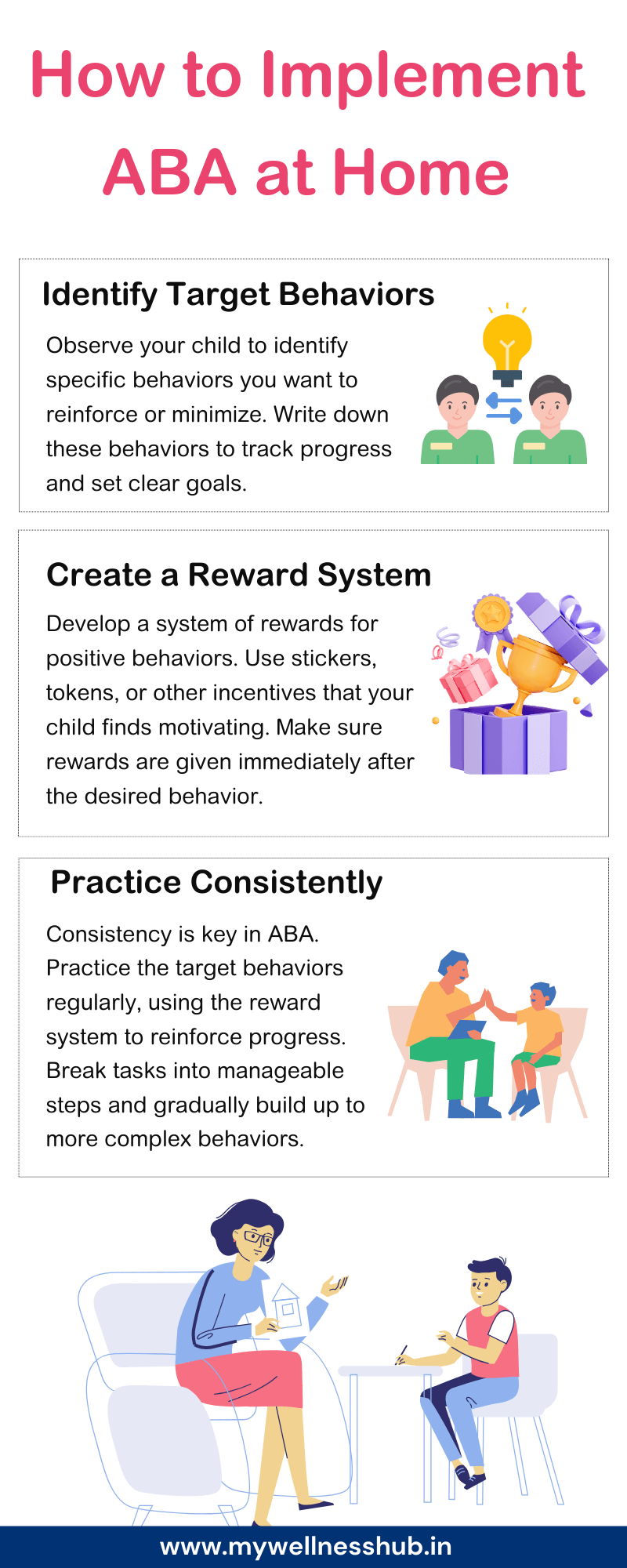
Applied Behavior Analysis is a well-known and widely used autism therapies for children. It focuses on teaching social, motor, and verbal behaviors by reinforcing desired behaviors and reducing unwanted ones. ABA is based on the principles of behavior modification, using rewards and consequences to encourage positive actions. This method has been proven effective in helping children with autism develop essential skills.
Implementing ABA at home can be straightforward and highly beneficial. Here are the steps to get started:
1. Identify Target Behaviors
First, observe your child and identify specific behaviors you want to reinforce or minimize. These can include everyday tasks like brushing teeth, dressing, or communication skills. Choose one behavior to focus on initially to avoid overwhelming your child.
2. Create a Reward System
Develop a system of rewards to reinforce positive behaviors. Rewards can be anything your child finds motivating, such as stickers, tokens, or extra playtime. The key is to ensure that the rewards are immediately given after the desired behavior to strengthen the association.
3. Practice Consistently
Consistency is crucial in ABA. Practice the targeted behavior regularly and use the reward system to reinforce it. For example, if you’re teaching your child to brush their teeth, break the task down into simple steps:
- Find the toothbrush.
- Wet the toothbrush.
- Apply toothpaste.
- Brush the top teeth.
- Brush the bottom teeth.
- Rinse the mouth.
Praise your child and provide a reward after each step they complete correctly. If they struggle with a step, guide them through it until they can do it independently. Over time, as your child masters each step, link the steps together to complete the full task.
4. Example: Brushing Teeth
Let’s say brushing teeth is the target behavior. Start by breaking down the activity into smaller, manageable steps. Show your child each step, helping them understand what is expected. Use hand-over-hand guidance if necessary. When your child successfully completes a step, offer immediate praise and a small reward, like a sticker. If they struggle, patiently repeat the step until they grasp it.
Sensory Play Activities
Children with autism may have heightened or reduced sensitivity to various sights, sounds, textures, smells, or tastes. Engaging in sensory play activities can help them become more comfortable with these sensations while supporting their overall development.
1. Sensory Bins
Sensory bins are easy to make and fun for children. They involve filling a container with different materials that offer various textures and sensations.
Here are some simple ideas:
2. Rice or Beans:
Fill a container with uncooked rice or beans. Add small toys, spoons, and cups for your child to scoop and pour. This helps them practice fine motor skills and is calming.
3. Sand or Water Beads:
Fill the bin with sand or water beads. Hide small toys in the sand or beads for your child to find. This activity is soothing and encourages exploration.
4. Water:
Fill a bin with water and add floating toys, cups, and spoons for scooping and pouring. You can add a bit of soap for bubbles to make it more fun. This helps your child learn about water and is very engaging.
Creative Play
Creative play activities such as using play dough, finger paints, or bubble blowing are excellent for sensory engagement and creativity. These activities can be easily set up at home and provide a range of sensory experiences:
- Play Dough: Playing with play dough can enhance tactile exploration and fine motor skills. You can make your own play dough at home using simple ingredients like flour, salt, water, and food coloring. Encourage your child to squeeze, roll, and mold the dough into different shapes.
- Finger Paints: Finger painting is a fun and messy way for children to explore different textures and colors. Use non-toxic, washable finger paints and large sheets of paper. Let your child create freely with their hands, enhancing their sensory and artistic expression.
- Bubble Blowing: Blowing bubbles is a wonderful activity that engages multiple senses. It involves visual tracking of the bubbles, the tactile sensation of popping them, and the motor skills required to blow them. This activity can be both calming and stimulating, depending on your child’s needs.
Speech and Language Practice
Speech therapy plays a crucial role in helping children with autism improve their communication skills. It can address a wide range of issues, from enhancing verbal abilities to developing nonverbal communication methods. Implementing speech therapy practices at home can significantly support your child’s progress and provide a consistent environment for learning.
1. Importance of Speech Therapy
Speech therapy is essential for children with autism as it helps them communicate more effectively, express their needs and desires, and interact socially with others. By working on speech and language skills, children can improve their ability to understand and use language, which is fundamental for their overall development and daily functioning.
2. Simple Strategies for Home Practice
Here are some straightforward and effective strategies you can use at home to support your child’s speech and language development:
Reading Together
Reading books with your child is a wonderful way to enhance their language skills. Choose books that are engaging and appropriate for their age and interests. As you read:
- Point to Pictures: Encourage your child to look at the pictures and describe what they see.
- Ask Questions: Ask simple questions about the story to promote interaction. For example, “What is the cat doing?”
- Repeat Words and Phrases: Repetition helps reinforce language. Repeat key words and phrases from the story to help your child learn them.
Using Visual Aids
Visual aids are powerful tools for supporting communication, especially for children who may have difficulty with verbal expression. Some effective visual aids include:
- Flashcards: Use flashcards with images and corresponding words to teach new vocabulary. Practice regularly to help your child recognize and remember the words.
- Picture Schedules: Create a visual schedule of daily activities using pictures. This helps your child understand the sequence of events and reduces anxiety about what comes next.
- Communication Boards: A communication board with pictures of common items and actions can help your child express their needs by pointing to the relevant image.
Singing Songs
Songs are a fun and engaging way to develop language skills. Music naturally incorporates rhythm, repetition, and rhyme, which are beneficial for language learning. When singing with your child:
- Choose Simple Songs: Start with simple, repetitive songs that are easy to remember.
- Use Actions: Incorporate actions with the songs to enhance understanding and make it more interactive.
- Encourage Participation: Encourage your child to sing along and perform the actions with you. This helps with memory and language use.
Floortime
Floortime is a play-based therapy designed to enhance emotional and social development in children with autism. It focuses on creating meaningful interactions by joining the child in their play activities and gradually introducing new elements to expand their play and communication skills. The primary goal of Floortime is to encourage back-and-forth interactions, helping children improve their social, emotional, and cognitive abilities.
Steps to Implement Floortime at Home
Floortime is a great way to connect with your child and support their development. Here’s how you can start using Floortime at home:
Observe and Join Your Child’s Play
Start with Observation:
- Watch your child play quietly.
- Notice what toys they like and how they play with them.
Join In:
- Sit on the floor with your child and use the same toys or activities.
- Copy their actions to show you are interested.
Follow Their Lead:
- Let your child guide the play.
- Follow their interests and let them set the pace.
Add New Elements Gradually
Introduce New Toys or Activities:
- Once your child is comfortable, add new toys or activities slowly.
- Try a new toy, game, or even new words.
Expand the Play:
- Encourage new ways of playing.
- If they stack blocks, suggest building a tower together.
- If they draw, introduce new colors or shapes.
Encourage Interaction:
- Foster back-and-forth interactions.
- Ask simple questions or make comments about what they are doing.
- For example, if they are playing with a toy car, say, “Where is the car going?” or “Can you drive the car to me?”
Be Patient and Responsive:
- Patience is key. Respond to your child’s actions and communication.
- Celebrate their efforts and progress, and be supportive even if they are hesitant to try new things.
Social Stories and Role Playing
Social stories are simple, descriptive tales that help children with autism understand everyday situations by explaining social cues and expected behaviors in easy terms. Role playing involves acting out these scenarios with dolls, action figures, or real-life practice, reinforcing the lessons learned. Together, these methods help children with autism better navigate and manage social situations.
Benefits of Social Stories and Role Playing
Social stories and role playing provide several benefits for children with autism:
- Enhanced Understanding: They help children understand social norms and expectations.
- Improved Social Skills: They teach appropriate social behaviors and responses.
- Reduced Anxiety: By preparing children for specific situations, they reduce anxiety and uncertainty.
- Increased Confidence: They build confidence by providing clear examples and practice opportunities.
Steps to Create and Use Social Stories
Creating and using social stories can easily fit into your daily routine. Here’s how:
Craft Simple Stories About Daily Situations
Identify Common Scenarios:
- Choose regular situations like “going to school,” “sharing toys,” or “waiting in line.”
Describe the Scenario:
- Write a simple story with clear, concise language. Include what happens, who is involved, and what behaviors are expected.
Use Positive Language:
- Focus on positive behaviors and outcomes. For example, “When I go to the playground, I wait my turn to use the slide. This makes my friends happy, and we all have fun.”
Include Visuals:
- Add pictures or drawings to illustrate the story. Visuals help children with autism understand and remember the content better.
Role Play with Dolls or Action Figures
Choose Characters:
- Use dolls, action figures, or stuffed animals to represent people in the social story.
Act Out the Story:
- Reenact the scenario using the characters. Narrate the actions and dialogue, encouraging your child to join in.
Practice Repeatedly:
- Repeat the role play several times to reinforce the behavior. Let your child take on different roles and try new responses.
Use Real-Life Practice:
- After role playing, practice the scenarios in real life. For example, after a story about sharing, encourage your child to share toys with a sibling or friend.
Picture Exchange Communication System (PECS)
The Picture Exchange Communication System is a valuable tool designed to help children with autism and other communication challenges express their needs and desires using pictures. This system provides an alternative means of communication for children who have difficulty with verbal expression, enabling them to interact more effectively with their environment and the people around them.
Description of PECS and Its Purpose
PECS uses pictures to help children communicate. Each picture represents an object, action, or concept. Children can select and exchange these pictures to express their needs, make requests, and share their thoughts. The main goal of PECS is to teach children functional communication skills, reducing frustration and improving social interaction.
Steps to Implement PECS at Home
Implementing PECS (Picture Exchange Communication System) at home can help your child communicate more effectively. Here’s how to get started:
Create a PECS Board
Select the Pictures:
- Choose pictures that show common items, actions, or emotions your child encounters daily, like favorite foods, toys, activities, or feelings.
Organize the Board:
- Arrange the pictures on a sturdy board or in a binder with Velcro strips. Make sure the board is at your child’s eye level and easy to access.
Label the Pictures:
- Label each picture with the corresponding word to help your child learn the words visually.
Encourage Your Child to Use Pictures to Communicate
Introduce the System:
- Show your child how to use the PECS board. Demonstrate how to select a picture and hand it to you to make a request. For example, guide them to choose a picture of their favorite snack when they want a snack.
Prompt and Reinforce:
- Prompt your child to use the pictures, if necessary, using hand-over-hand assistance. Immediately fulfill their request and praise them to encourage continued use.
Expand Vocabulary:
- Gradually introduce new pictures to expand your child’s vocabulary. Include various items, actions, and emotions to cover different aspects of daily life.
Practice Regularly:
- Consistency is key. Use PECS daily and encourage your child to use the pictures for making requests, expressing feelings, or commenting on their surroundings.
Monitor Progress:
- Track your child’s progress and adjust the PECS board as needed. As they become more proficient, introduce more complex pictures and concepts.
Structured Play and Routine
Importance of Structure and Routine for Children with Autism
For children with autism, structure and routine are essential. Predictable routines provide a sense of security and help reduce anxiety, making it easier for them to navigate their day. A structured environment helps children understand what is expected of them, which can improve their behavior and learning. By establishing clear routines, you can create a stable and supportive environment that promotes your child’s development and well-being.
Steps to Establish a Structured Routine
Creating a structured routine involves setting specific times for various activities and using visual aids to help your child transition smoothly between them. Here are the steps to get started:
Designate Specific Play Times
- Set Regular Playtimes: Designate specific times each day for play activities. Consistent playtimes help your child anticipate and prepare for these periods, reducing any anxiety about what comes next.
- Choose a Variety of Activities: Include a mix of activities in the play schedule. This can range from physical play like jumping and running to quiet play like puzzles and drawing. Having a variety of activities ensures that your child is engaged and stimulated.
- Stick to the Schedule: Consistency is key. Try to stick to the same schedule every day to reinforce the routine. This consistency helps your child feel secure and understand what to expect.
Use Visual Schedules to Transition Between Activities
- Create a Visual Schedule: Use pictures to represent different activities and create a visual schedule. This can be a chart on the wall or a portable board that your child can carry with them. Each picture should clearly show the activity and its corresponding time.
- Explain the Schedule: Go through the visual schedule with your child each morning. Explain what each picture represents and the order of activities. This helps your child understand the day’s structure and prepares them for transitions.
- Use Timers: Set timers to signal the beginning and end of each activity. Timers help children understand that one activity is ending and another is beginning, making transitions smoother. You can use visual timers that show the remaining time, which can be particularly helpful for children with autism.
- Provide Warnings: Give your child a warning a few minutes before an activity changes. For example, say, “In five minutes, it will be time to clean up and start our reading time.” This gives them time to adjust and prepares them for the transition.
- Be Flexible: While consistency is important, it’s also crucial to be flexible. If something isn’t working or if your child is having a difficult day, be willing to adjust the schedule as needed. The goal is to create a supportive environment, not to add stress.
Conclusion
Incorporating structured routines and visual schedules can greatly benefit your child by reducing anxiety and providing a sense of security. Consistency in daily activities, coupled with flexibility when needed, helps children manage transitions more smoothly. Using pictures to represent tasks and setting timers can make the process easier and more engaging. These strategies foster emotional well-being and enhance the effectiveness of home-based therapy. Visit Wellness Hub for expert guidance and valuable resources to further support your child’s progress and create a balanced, nurturing environment at home. Discover more tips on creating structured routines today.
Frequently Asked Questions:
1. What are the benefits of home-based autism therapies?
Home-based autism therapies provide a convenient and cost-effective way to support your child’s development. They allow parents to integrate therapeutic activities into daily routines, fostering a stronger bond with their child and creating a supportive environment tailored to their needs.
2. How can I start implementing Applied Behavior Analysis (ABA) at home?
To start implementing ABA at home, identify target behaviors you want to reinforce, create a reward system, and practice consistently. Break down tasks into simple steps, use positive reinforcement, and gradually build up to more complex behaviors.
3. What are some effective sensory play activities for children with autism?
Effective sensory play activities include creating sensory bins filled with materials like rice or beans, engaging in creative play with play dough or finger paints, and activities like bubble blowing. These activities help children explore different textures and sensations in a fun and controlled way.
4. How can I support my child’s speech and language development at home?
You can support your child’s speech and language development by reading together, using visual aids like flashcards and picture schedules, and singing songs. These activities promote communication skills and provide opportunities for regular practice.
5. What is Floortime and how can I use it with my child?
Floortime is a play-based therapy that focuses on creating meaningful interactions with your child. To use Floortime, observe and join your child’s play, follow their lead, and gradually introduce new elements to expand their play and communication skills.
6. How do social stories and role playing help children with autism?
Social stories and role playing help children with autism understand social norms and expected behaviors. By crafting simple stories about daily situations and using role play with dolls or action figures, children can practice and reinforce appropriate social interactions.
7. What is the Picture Exchange Communication System (PECS) and how can I implement it at home?
PECS is a communication tool that uses pictures to help children with autism express their needs. To implement PECS at home, create a PECS board with pictures of common items and actions, and encourage your child to use the pictures to communicate by exchanging them for desired objects or actions.
8. Why is structure and routine important for children with autism?
Structure and routine provide predictability and reduce anxiety for children with autism. A consistent schedule helps them understand what to expect each day, making it easier to navigate daily activities and improving their behavior and learning.
9. How can I establish a structured routine for my child?
To establish a structured routine, designate specific playtimes, use visual schedules to represent different activities, and set timers to signal transitions. Consistency is key, but be flexible and willing to adjust the schedule as needed to support your child’s well-being.
10. Where can I find more resources on home-based autism therapies?
For more resources on home-based autism therapies, visit Wellness Hub. You can find additional support and information tailored to your needs, helping you make the most of your home-based therapy sessions.
About the Author:
Anuradha Karanam
Speech-language pathologist (7+ years of experience)
Anuradha Karanam is a skilled speech-language pathologist with over 6 years of experience. Fluent in Tamil, Telugu, Hindi, and English, she specializes in parent counseling, speech sound disorders, fluency assessment, and speech-language evaluations. Anuradha excels at working with children with developmental disorders, offering creative and effective therapy programs. Currently, at Wellness Hub, she holds a BASLP degree and is registered with the RCI (CRR No A85500). Her patience, ambition, and dedication make her a trusted expert in her field.
Book your Free Consultation Today
Parent/Caregiver Info:
Client’s Details:
* Error Message

